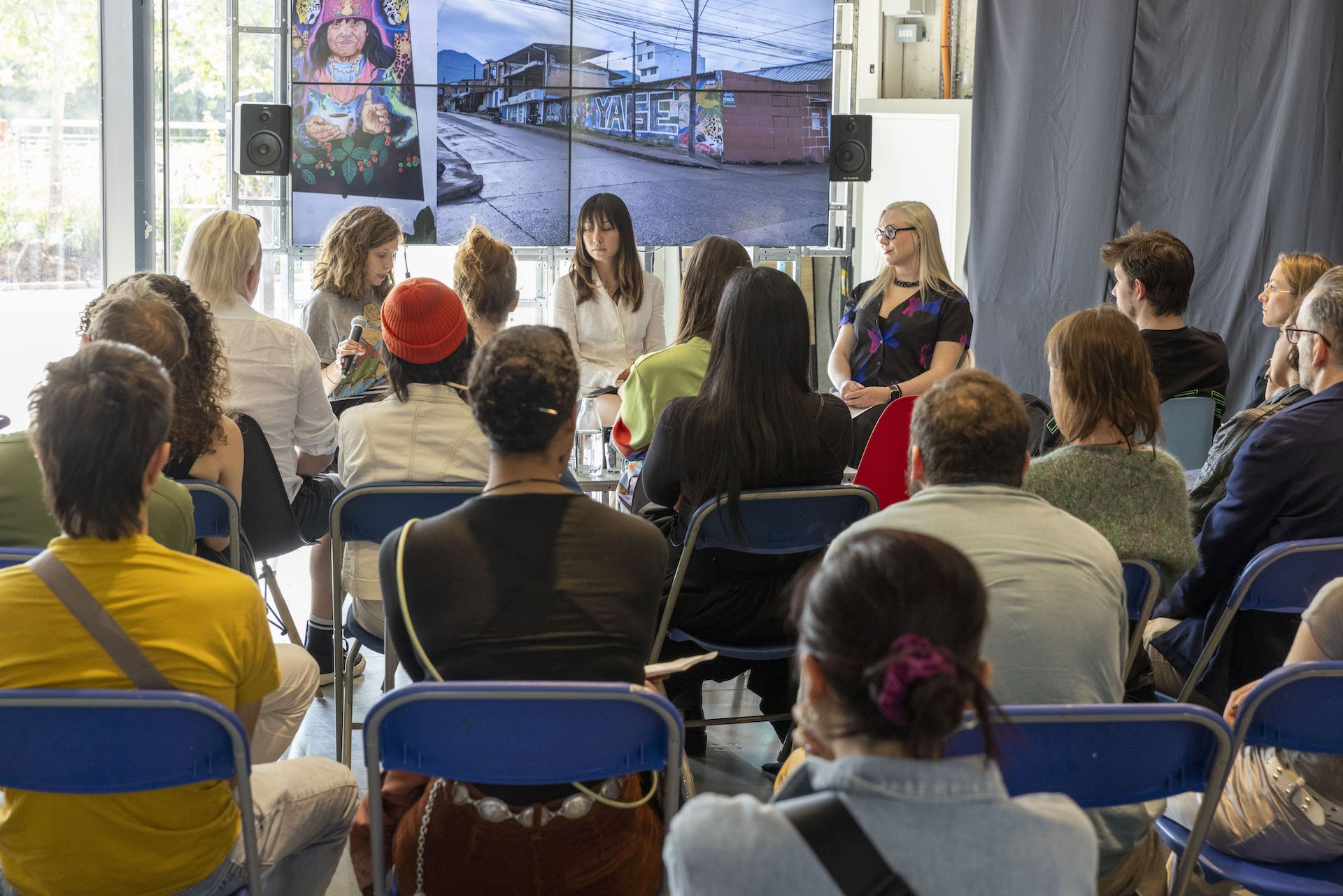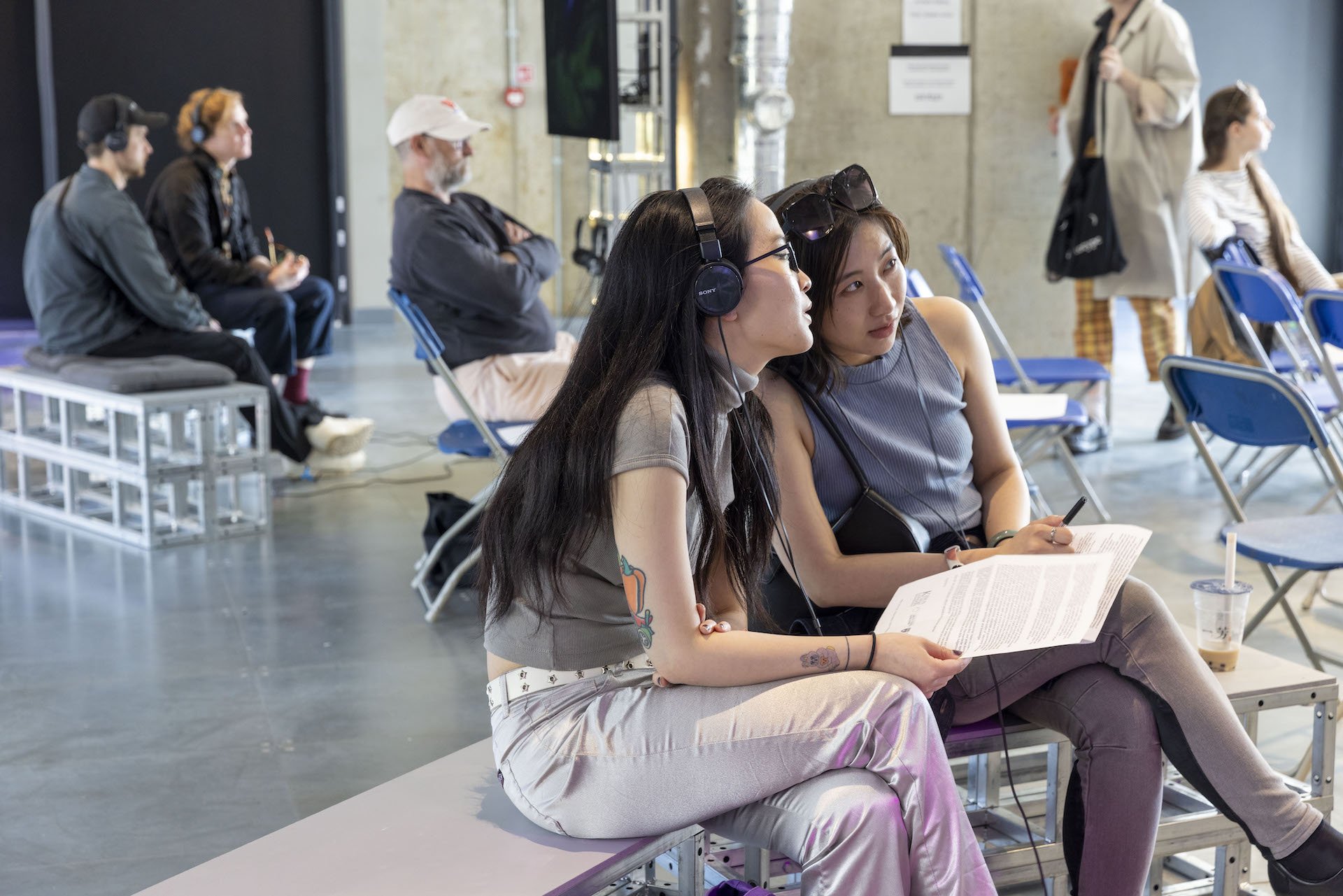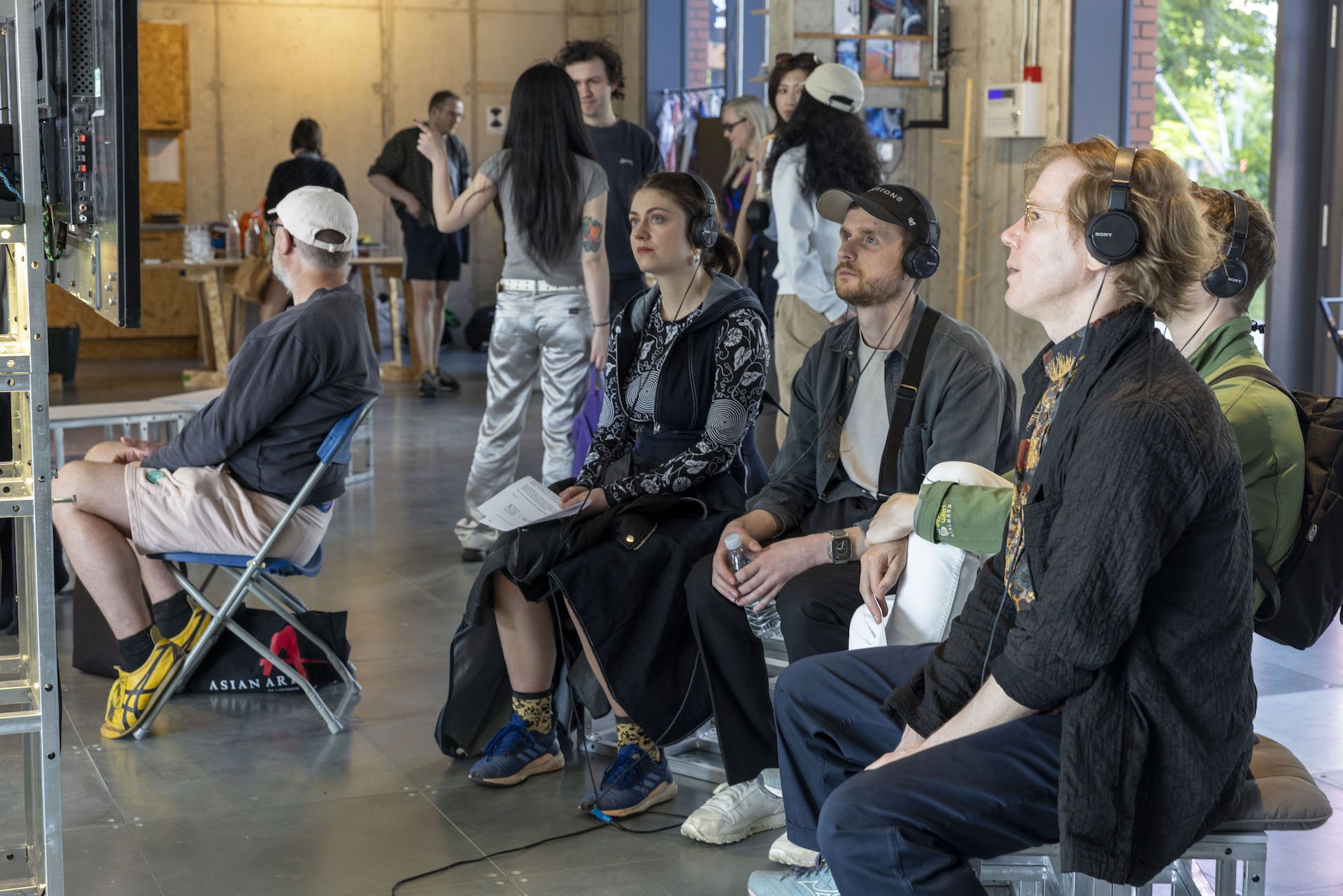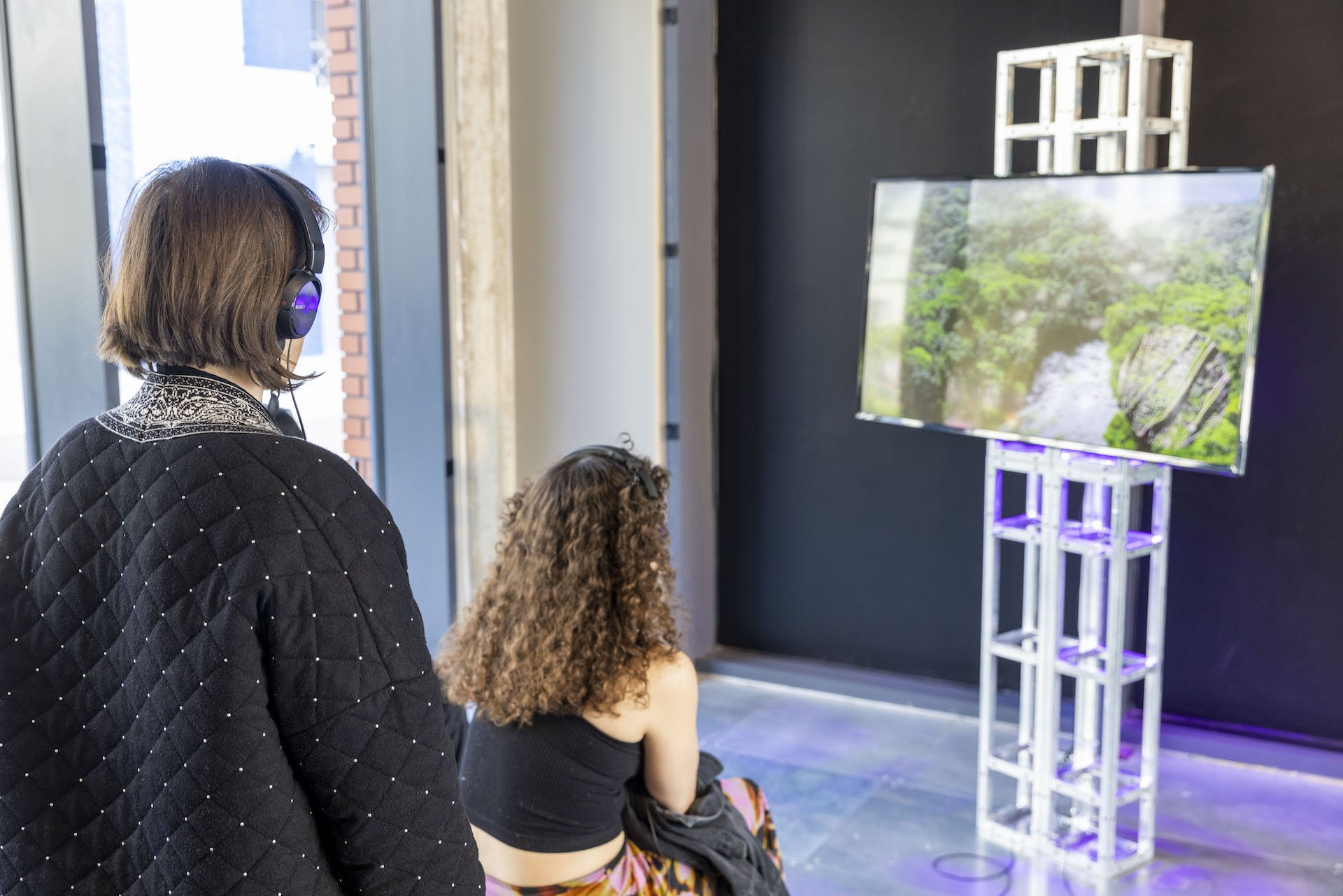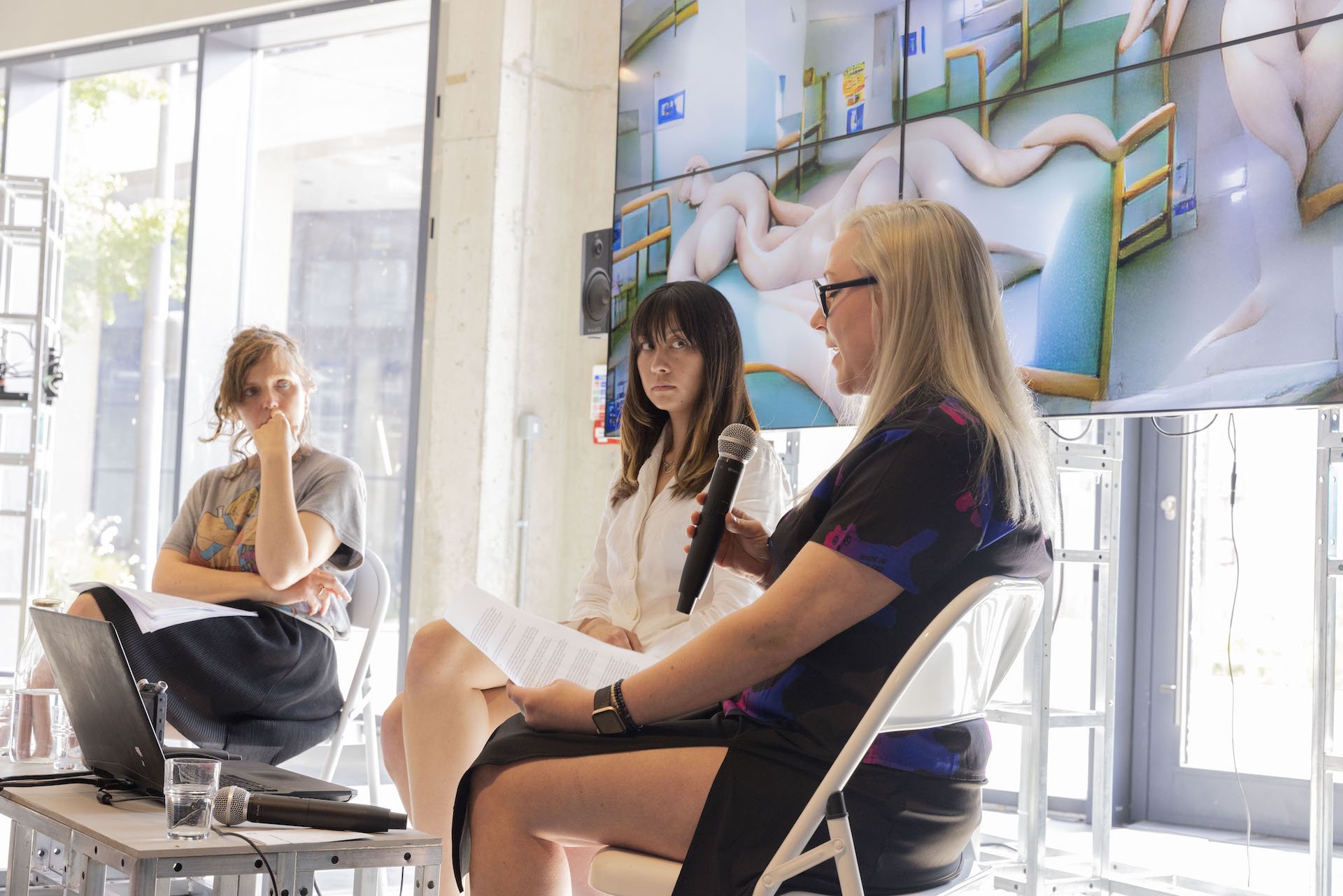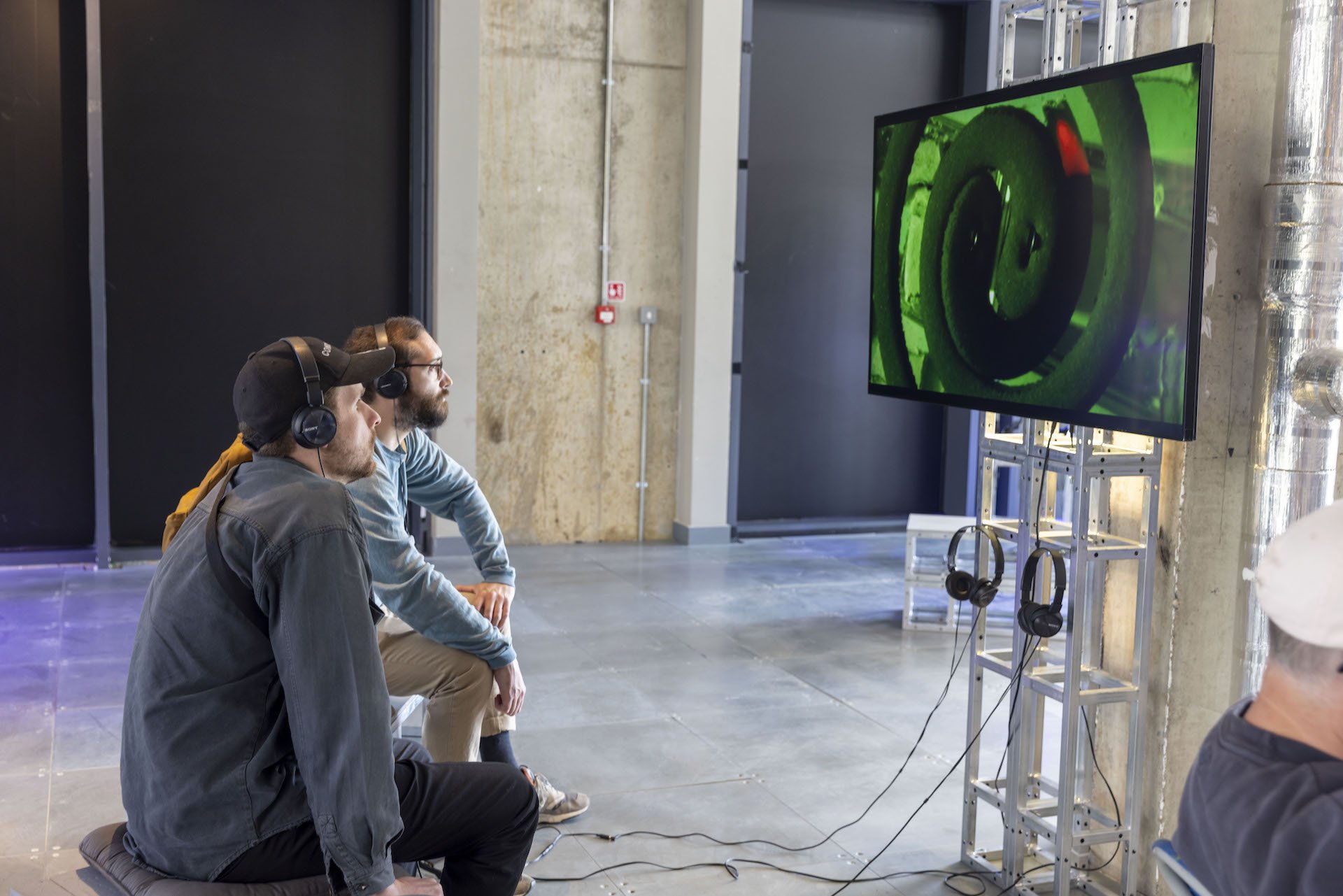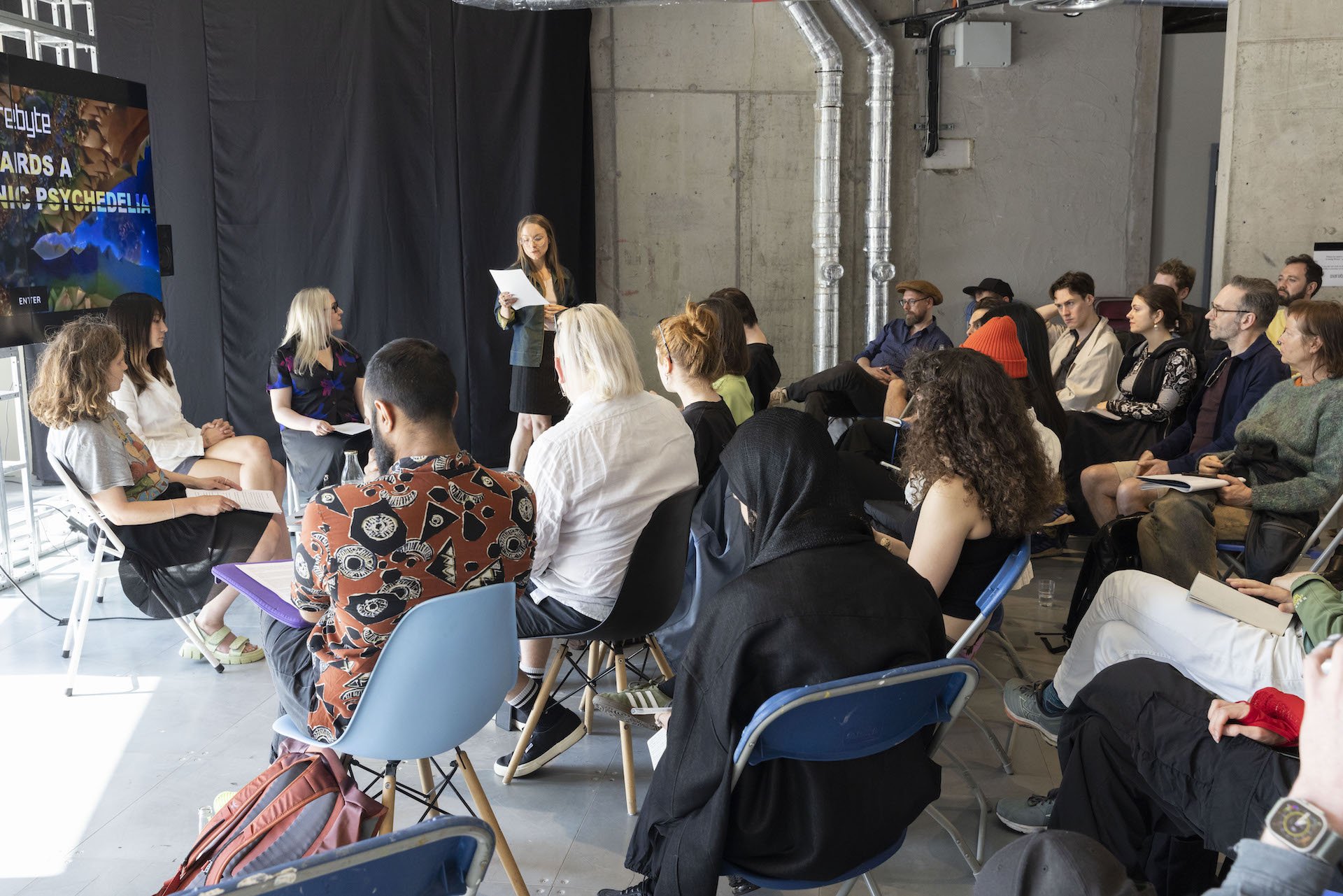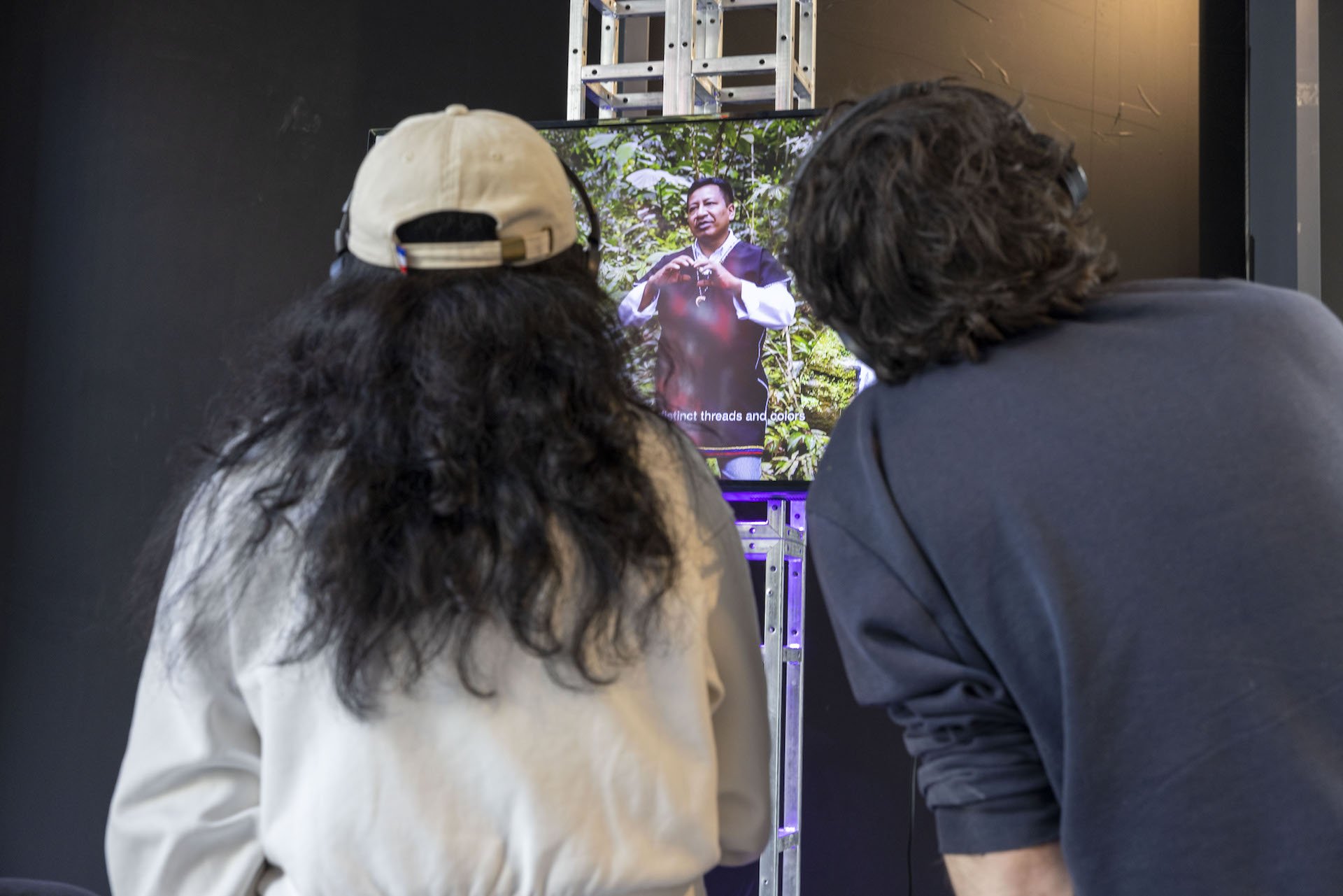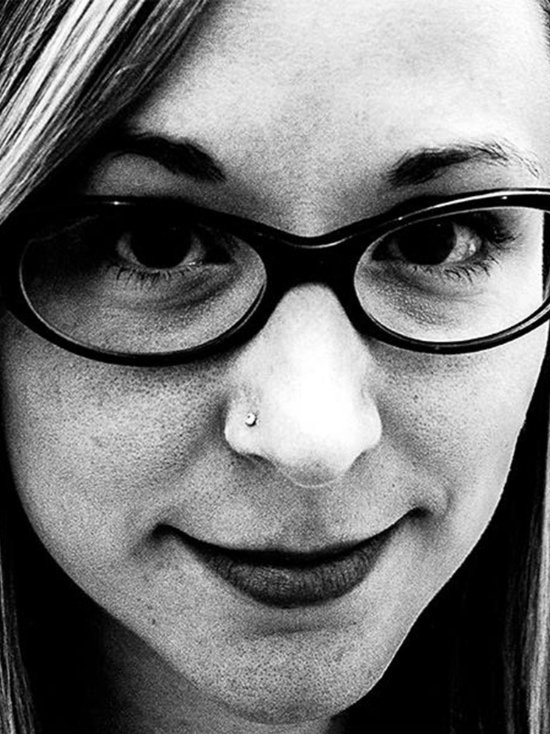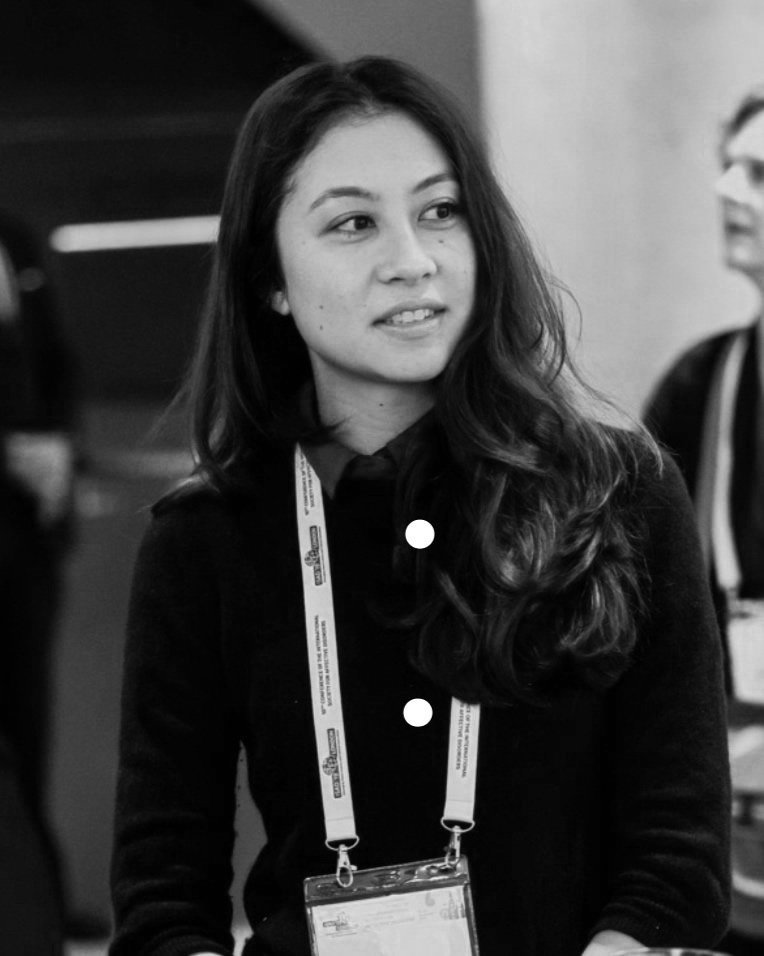Towards a Cosmotechnic Psychedelia
Film screenings and panel discussion in collaboration with Helen Knowles
Sat 27 May 2023, 1 - 5:30pm
Part of arebyte 2023/24 programme The Body, The Mind, The Soul
Psychedelia and technology beyond the West:
A cinematic journey towards collective awareness and connection.
Presented in collaboration with artist and researcher Helen Knowles, Towards a Cosmotechnic Psychedelia is a screening event followed by a panel conversation looking at alternate states, entity encounters, differing ethical, moral, and social forces, as described in Yuk Hui's concept of 'cosmotechnics'. A framework that continues to shape use of psychedelics and plant-based medicinal tools both in Global South’s communities, like Putumayo in Colombia, and in affluent Western societies.
The event is part of Helen's current PhD research, titled "More Than Human Healthcare", which involves collaborations with the Psychedelic Trials Team at King's College London, the London AI Centre, and members of the Inga community in Putumayo, Colombia.
The screening includes the experimental documentary True Hallucinations, directed by Péter Bergmann based on Terence McKenna’s book Journey to La Chorerra. The film details his brother's journey to Putumayo and the experiments that ensued, blending 90s computational aesthetics with found footage of McKenna and his brother, alongside McKenna’s famously hypnotic oration. This complex historical work forms the basis for understanding the problematic, extractive, Western-centric botanical objective to discover and sail the psychonautical seas of inner consciousness.
-
From here we see more contemporary takes on the points raised (or ignored) in McKenna’s lifework: Ursula Biemann’s exploration of intelligence in nature from both shamanic and scientific perspectives and Patricia Dominguez’s enquiry into experimental ethnobotany and organic connection technologies that expand the perception of the vegetal and the spiritual world. Looking towards an embodied approach of psychedelics in medicine and mental health, Andrea Khora visualises the effects of 10mg of ketamine inserted intravenously, creating hallucinogenic and otherworldly images. Suzanne Triester approaches non-colonialist plans towards a techno-spiritual imaginary of alternative visions of survival on earth via a body of work titled Technoshamanism. This sees an expansion and redefinition of technology that is engineered and redirected in new ways for global positive futures away from mainstream economic, corporate and governmental forces. Rebeca Romero’s Voyager also questions the legitimacy of the notion of “discovery” and proposes a reassessment of dominant notions of intelligence, technology, and knowledge.
EVENT PROGRAMME
1.00 - 3.50pm :
Film screening
Péter Bergmann, Terence McKenna's True Hallucinations - 2h 48’
You can also watch the film here at home ahead of the panel conversation
1.00 - 3.50pm:
Film screenings, on loop
Andrea Khora, Bolus - 4’31”
Patricia Domínguez, Matrix Vegetal - 21’
Rebeca Romero, Voyager - 5’45”
Suzanne Treister, Technoshamanic systems - 3’26”
Ursula Biemann, Forest Mind - 31’
4.00 - 5.30pm :
panel talk
Helen Knowles, artist and researcher
Catherine Bird, Clinical Trials Manager
Andrea Khora, artist
With contributions from Dr. Hernando Chindoy Chindoy, former Representante legal de la Entidad Territorial AWAI del Pueblo Inga de Colombia and co-founder of the AWAI Indigenous University.
Listen to the panel discussion below
Helen Knowles (00:00), Andrea Khora (20:54), Catherine Bird (29:11)
Panel Discussion
The screening is followed by a panel conversation with artist and researcher Helen Knowles, King’s College Clinical Trials Manager and psychedelic researcher, Catherine Bird, and artist Andrea Khora, with contributions from Dr. Hernando Chindoy Chindoy, former Representante legal de la Entidad Territorial AWAI del Pueblo Inga de Colombia and co-founder of the AWAI Indigenous University.
The conversation aims at looking beyond the West to move towards anti-universalist and pluralist perspectives on technologies and tools of connection, and explore how artistic interventions and methods of narrative-building can assist us in creating collective awareness and connection in the contemporary context of the climate emergency.
How can we cement solidarity without extractive or hierarchical agendas?
Helen Knowles
Artist, researcher
-
Helen Knowles (b.1975) is an artist and curator of the Birth Rites Collection. Recent shows include; Hyundai Motor Studio, Beijing (2022), Illingworth Kerr Gallery , Alberta, 'Ars Electronica' Austria, (2020). The Mori Art Museum, Tokyo, NEMO, Paris, Hannover Kunstverein (2019) ‘Impakt Festival, Centro del Carme, Valencia, ZKM Germany, Zabludowicz Collection, London (2017). Knowles received an honorary mention in ARS ELECTRONICA Interactive Section, (2020). Her work is held in collections including The Whitworth Art Gallery & Tate Library and Archive. She began her PhD studentship at Northumbria University in 2021, under the guidance of Christine Borland, Fiona Crisp and Tehseen Noorani.
Instagram: @helenknowles001
Andrea Khora
Artist
-
Andrea Khôra is an artist and researcher based in London. Her practice seeks to comprehend the malleability of reality on personal and societal scales. As a PhD researcher in the Art Department at Goldsmiths, her practice-led project New Sight: The Alchemy of Surveillance into Resistance in Near Future Worlds looks at the history of surveillance, specifically focusing on the mining of occult knowledge systems by the CIA in the cold war as well as the correlation between 1960s-1970s utopian countercultures and the rise of Surveillance Capitalism. Through the uncovering of systems and correlations, she is creating a speculative proposition for the future reclamation of personal and community agency through the creation of sculpture, writing, and performance.
Instagram: @andrea_khora
Catherine Bird
Psychedelic researcher
-
Catherine Bird is the Senior Clinical Trials Manager, Psychoactive Trials Group, Centre for Affective Disorders, Institute of Psychiatry, Psychology & Neuroscience (IoPPN). She works in psychedelic research as part of the psilocybin research group at The Institute of Psychiatry, Psychology and Neuroscience, King’s College London.
Instagram: @andrea_khora
Featured Works
-
Péter Bergmann is a Hungarian electronic music artist from Budapest, who since 2010 has produced seven full studio albums of uplifting songs. In the ten years between 2012 and 2022 he has created over five hundred videos related to the late ethnobotanist and philosopher Terence McKenna and published them on his YouTube channel. In 2014 Peter released his first documentary about the ideas of Terence McKenna titled "The Transcendental Object At The End Of Time", which encompasses McKenna's most famous ideas and insights. However a story was yet to be told, McKenna's most famous true story of venturing into the Amazon rainforest in Colombia to find an elusive psychedelic substance called oo-koo-hay, which turned into a life changing adventure thanks to an abundance of psilocybin mushrooms at the remote location he and his friends found themselves in. The experimental documentary "Terence McKenna's True Hallucinations" was released in 2016.
Thanks to some meme magic in the form of fake movie posters, a rumor was launched which was written about in major news outlets all over the world, that Jim Carrey was about to star as Terence McKenna in the live action version of the story. That never happened but the documentary has reached millions of viewers.
Instagram @wpahp
Péter Bergmann, Terence McKenna's True Hallucinations (2016)
An experimental documentary about the chaos at La Chorrera, the imagination, time, the Logos, belief, hope, madness, and doubt, and an expansion of ideas first presented in The Transcendental Object At The End Of Time. In 1971, Terence McKenna, his brother Dennis and 3 others ventured by plane, boat and foot to the paradisical Colombian mission town La Chorrera, where they hoped to encounter the elusive psychedelic oo-koo-hé. Fate would have it otherwise. Their attention soon turned to the large numbers of Stropharia Cubensis that they lucked upon, and before long, Terence and Dennis were formulating the psychopharmacological "experiment at La Chorrera" which would eventually give rise to Terence's expanded Jungian notion of the UFO as human oversoul, and his I Ching based TimeWave Theory which holds that history as we know it is accelerating and will come to a major concrescence. Based on the book True Hallucinations: Being an Account of the Author's Extraordinary Adventures in the Devil's Paradise, this tale of alchemical understanding is a deep dive into the minds of the McKenna brothers, and an effort to provide some visual aid and emotional center to a much larger story.
-
Andrea Khôra is an artist and researcher based in London. Her practice seeks to comprehend the malleability of reality on personal and societal scales. As a PhD researcher in the Art Department at Goldsmiths, her practice-led project New Sight: The Alchemy of Surveillance into Resistance in Near Future Worlds looks at the history of surveillance, specifically focusing on the mining of occult knowledge systems by the CIA in the cold war as well as the correlation between 1960s-1970s utopian countercultures and the rise of Surveillance Capitalism. Through the uncovering of systems and correlations, she is creating a speculative proposition for the future reclamation of personal and community agency through the creation of sculpture, writing, and performance.
Instagram @andrea_khora
Andrea Khora, BOLUS, 2022
First, the IV cannula is inserted in the vein — this can be done on the hand, wrist, or inside of the elbow, ideally, on the left hand. The saline is flushed through to prime the IV, the ketamine is then mixed with saline and placed into a syringe, which is placed into the infusion pump.
A slow but steady infusion of the medication begins, 85 MG over the course of one hour.
After approximately ten minutes, the patient receives a bolus of 10 MG of ketamine directly into the IV.
This ensures a dissociative episode for the patient.
More information here
-
Patricia Domínguez is an artist, educator and earth defender based in Puchuncaví, Chile. She is the founder of Studio Vegetalista, an experimental platform for ethnobotanical research based in Chile.
Bringing together experimental research on ethnobotany, healing practices and the corporatization of wellbeing, her practice focuses on challenging the increasingly globalized corporate cosmologies that are emerging, by tracing the precarious relationships between species that are contextualized the current digitization of the living. Her installations take the form sculptures, videos and publications which are designed to exorcise the effects of late capitalism and ecological destruction in the physical and social body, while exploring the emancipatory potential of artistic imagination as a form of psychic emancipation and as a path of healing our colonial trauma.
Patricia Domínguez, Matrix Vetegal, 2022
Departing from the artistic interpretation of Domínguez's learning in Madre de Dios (Peru), Matrix Vegetal grows as an inquiry from experimental ethnobotany, South American quantum thinking, dream fiction, and organic connection technologies to expand the perception of the vegetal and the spiritual world. The artist spent a month of apprenticeship with Amador Aniceto, a healer and curandero living and practicing in Madre de Dios. Under his guidance, Domínguez has activated an intimate process of connecting with the living, multi-species language and knowledge of the vegetal world, aimed at achieving a temporary disengagement from the “digital matrix,” activating an alliance with plants and the vegetal matrix instead, through patience and focus on the present moment. In doing so, Domínguez establishes a connection with the more-than-human language of the earth, and speculatively accesses a portal to the quantum world, revealing how plants and their multiple spirits operate. Matrix Vegetal also includes a video interview with Amador Aniceto, highlighting his personal view and experience of the plant world. More info here
-
Rebeca Romero is an interdisciplinary artist born in Peru and based in London.
Through a range of media that includes sculpture, ceramics, textiles, sound, performance and video, she explores concepts of diasporic identity, truth, fiction, and their relationship to the digital age.
Often combining Pre-Columbian iconography with advanced scanning and printing technologies and materials ranging from clay to plastic, her works swing drastically between the past and an alternate future. Examining the story-telling potential of artefacts, Romero looks into the intervention of the digital archive as a history-making technique. Online museum archives become an excavation ground for the collection of data that she later recontextualizes, reassembles and re-presents.
With a focus on new materialities, processes of production and collaboration between artist and machine, her work seeks to question ideas and practices of representation, appropriation and authorship. The recent inclusion of AI image generators into her work proposes a further re-understanding of hegemonic notions of intelligence, technology and knowledge.
Instagram @romero.beca
Rebeca Romero, Voyager, 2020
Through a non-linear process of digital excavation and assemblage, Voyager creates speculative connections that span across time and space.
Focusing on the encounter between European and Indigenous cultures, the film questions the legitimacy of the notion of 'discovery'.
By exploring modes of cultural appropriation and different types of encounters and exchange, the work proposes a reassessment of dominant notions of intelligence, technology and knowledge.
More info here
-
Suzanne Treister (b.1958 London UK) studied at St Martin's School of Art, London (1978-1981) and Chelsea College of Art and Design, London (1981-1982) based in London having lived in Australia, New York and Berlin. Initially recognized in the 1980s as a painter, she became a pioneer in the digital/new media/web based field from the beginning of the 1990s, making work about emerging technologies, developing fictional worlds and international collaborative organisations. Utilising various media, including video, the internet, interactive technologies, photography, drawing and watercolour, Treister has evolved a large body of work which engages with eccentric narratives and unconventional bodies of research to reveal structures that bind power, identity and knowledge. Often spanning several years, her projects comprise fantastic reinterpretations of given taxonomies and histories that examine the existence of covert, unseen forces at work in the world, whether corporate, military or paranormal. An ongoing focus of her work is the relationship between new technologies, society, alternative belief systems and the potential futures of humanity.
Suzanne Treister, TECHNOSHAMANIC SYSTEMS: Intro video, 2020 -
TECHNOSHAMANIC SYSTEMS presents technovisionary non-colonialist plans towards a techno-spiritual imaginary of alternative visions of survival on earth and inhabitation of the cosmos.
TECHNOSHAMANIC SYSTEMS encourages an ethical unification of art, spirituality, science and technology through hypnotic visions of our potential communal futures on Earth alongside those of possible extraterrestrial entities or civilisations.
Countering invasive agendas of governments and the private space industry, TECHNOSHAMANIC SYSTEMS proposes a political metamorphosis and transmutation of human consciousness towards a new Earthly and interplanetary paradigm.
Link for more information here
-
Ursula Biemann is an artist, author, and video essayist. Her artistic practice is strongly research oriented and involves fieldwork in remote locations from Greenland to Amazonia, where she investigates climate change and the ecologies of oil, ice, forests and water.
In her multi-layered videos, the artist interweaves vast cinematic landscapes with documentary footage, SF poetry and academic findings to narrate a changing planetary reality. Biemann’s pluralistic practice spans a range of media including experimental video, interview, text, performance, photography, cartography, props and materials, which converge in formalized spatial installations. Her work also adopts the form of publications, lectures, and curatorial as well as collaborative research projects.
Instagram @ursulabiemann1
Ursula Biemann, Forest Mind, 2021
Located in the Amazonian forests of Colombia, Forest Mind unites diverse strands of knowledge on the metaphysics of plants, on plant-human relationships, and the coding of life with its form of storing information.
Drawing on scientific as well as shamanic perspectives of engaging with the world, the video takes an ecocentric worldview in search for the intelligence of nature.
Première at Kunsthaus Zurich, Earth Beats exhibition, October 8, 2021- February 6, 2022. Forest Mind received Honorary Mention at the 15th Cuenca Biennial 2021.
More info here


